Ensuring the Lowest Distribution / Transmission Loss
The objective of the distribution network is to transport steam from the point of generation in the boiler to the point of usage with the lowest transmission loss so as to reduce operating costs.
The ideal steam distribution loss should only be about 3%, even for a large and complex distribution network. In reality however, distribution losses in most plants range between 5-8%. High distribution losses can be attributed to a number of factors including oversized steam lines, poor insulation health, direct steam leaks and steam loss from leaking traps and valves.
Heat naturally flows from a warmer to a cooler area. Heat from the steam pipeline is lost to the surrounding environment through radiation as well as convection.
This results in condensation as well as a drop in temperature of steam flowing in the line. Insulation, made up of materials which are poor conductors of heat, acts as a barrier and prevents the flow of heat from the steam through the pipeline wall to the surrounding environment. This helps to reduce radiation and convection losses enabling steam to travel further and maintain its temperature over longer distances without condensing.
Lower distribution losses reduces overall cost of operation by cutting down fuel consumption. Insulation also prevents safety hazards of scalding by lowering the exposed surface temperatures of steam lines and additionally reduces the overall ambient working temperature.
Ilustration:
Consider the heat loss through a 6″ pipe carrying steam at 7 barg pressure.
| Loss from an uninsulated pipe / meter | Loss from an insulated pipe / meter |
|---|---|
| 250Kcal/hr | 50Kcal/hr |
Effective insulation thus reduces energy waste by 80% over an uninsulated pipeline. For the same example, the illustration below highlights the impact of surface temperature / inadequate insulation on heat loss and consequently fuel loss.
The ambient temperature T(Amb) = 30C.
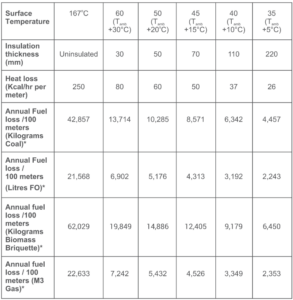
Optimum thermal insulation delivers the following benefits :
- Ensures steam quality by reducing condensation of steam in the pipelines
- Reduces distribution losses and hence operating costs
- Prevents safety hazards of scalding by lowering the exposed surface temperatures of steam and condensate lines
- Reduces overall ambient working temperature of the surroundings
Ideally, the surface temperature of the insulation cladding should not exceed the ambient temperature by more than 10C. The health of the insulation should also be checked periodically by thermography.
A typical output of a thermal imaging camera is illustrated below. There is no way of knowing that the insulation health needs to be addressed simply by looking at the steam line. However, a thermographic analysis indicates that the surface temperature exceeds 70C.
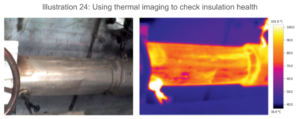
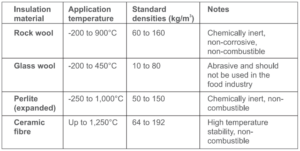
Keep insulation dry
The effectiveness of most insulation materials depends on minute air cells which are held in a matrix of material such as mineral wool, fibreglass or calcium silicate. Thermal conductivity of air is very low i.e. 0.025 W/mC and air impedes heat loss. As insulation material is porous, it can readily absorb water. Steam distribution networks across plants are typically exposed to the weather and are susceptible to the ingress of moisture / water. Water has a thermal conductivity of 0.6W/m”C which is significantly higher than that of air. Energy loss due to wet insulation occurs on two counts :
- Reduction in the efficiency of insulation leading to higher radiation losses to the surroundings
- Energy lost to evaporate the water contained in the insulation
As per good engineering practices, insulation material should be protected with proper cladding. Cladding serves two purposes i.e. functional and aesthetics. It helps to protect the insulation material and helps to prevent damage from exposure to the environment.
Typically aluminium or galvanised steel is used as cladding. The thickness of the cladding should be selected based on the degree of mechanical damage which it is expected to withstand. Cladding should be periodically inspected for damage and replaced to prevent water ingress.
Overlapping and riveting of insulation cladding should always be done at the 4 o’clock or 8 o’clock position to avoid water ingress.
Radiation losses from a steam line with wet insulation are significantly higher than a bare steam pipeline. Cladding is installed on the line to protect insulation from the environment and prevent water ingress. However, often due to ease of installation the overlap and riveting of the dadding is done at the 12 o’clock position. This can lead to rainwater ingress in the insulation.
Maintaining the overlap and riveting at the 4 o’clock or 8 o’clock position eliminates the chances of rain water ingress.
Based on our observations across thousands of plants, we find that while there is some form of insulation on pipelines, accessories like valves, moisture separators and traps are often left uninsulated.
The thermal image of a steam distribution header (below), is taken at one such plant. While the header and the offtake lines are insulated, the valves remain uninsulated. This not only results in energy loss but also poses a danger of scaling to personnel.

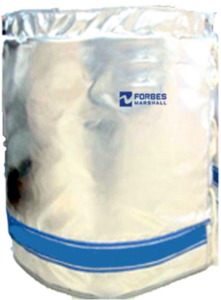
Accessories are often left uninsulated due to the need to carry out periodic maintenance on them, Removing and re-fixing conventional insulation is both time consuming and cumbersome.
Removable insulation jackets address this issue.
They are available for a wide range of steam and condensate accessories including isolation/control valves, moisture separators, steam traps, flash vessels and condensate recovery pumps.
Depending on the steam pressure, size of the leak and how long it remains unrepaired, each steam leak can waste hundreds of kilograms of steam per year.
The chart below helps calculate the loss of steam in kilograms/ hour depending on the steam pressure and the size of the leak.

For example a 1/8th inch hole can waste 12 tons of Furnace Oil or 22 tons of coal per year. Attending to steam leaks as quickly as possible can not only save fuel but also reduce water consumption and CO2 emissions.
Ensure uptime of the distribution steam trapping system:
Across plants, we find that the average uptime of mainline distribution traps is only 71%. Steam traps can fail in two main ways i.e. either closed or open. When traps fail closed they prevent condensate from being evacuated causing waterlogging. This can lead to wet steam / water hammer.
However, when traps fall open, they leak steam, resulting in energy losses in the range of 7-10%. A single leaking trap can
cause steam loss of 218 tons / year, increasing fuel consumption and CO, emissions. The table below illustrates the steam loss through a leaking trap.
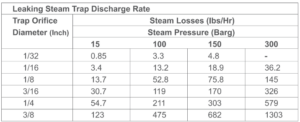
Steam traps installed in the distribution network can fail due to several reasons including improper selection, installation and maintenance. Implementing an effective steam trap maintenance program steam traps. helps sustain uptime. The table below illustrates the periodic maintenance schedule to be followed for steam traps.
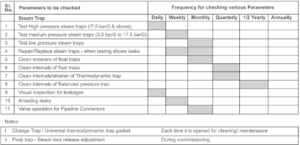
Monitor the gap between steam generation and consumption
Monitoring the gap between steam generation and consumption is important as it gives an indication of the steam distribution system efficiency and a direct measure of the distribution losses in the plant. The ideal distribution losses should not exceed 3% even in complex and vast plants. A gap exceeding 3-4% can be an indication of poor insulation health, direct steam leaks or steam loss through traps.
Carry out periodic calibration of diagnostic equipment
Over time, the accuracy of gauges and meters can diminish, compromising their ability to provide precise measurements. Periodic calibration ensures the precision of these instruments, guaranteeing accuracy. Compliance with statutory requirements often necessitates uninterrupted and precise measurements, and periodic calibration ensures adherence to regulations. Additionally, precise measurements also enables accurate control over key steam and process parameters, facilitates troubleshooting, ensures safe operations and precise cost allocation.
